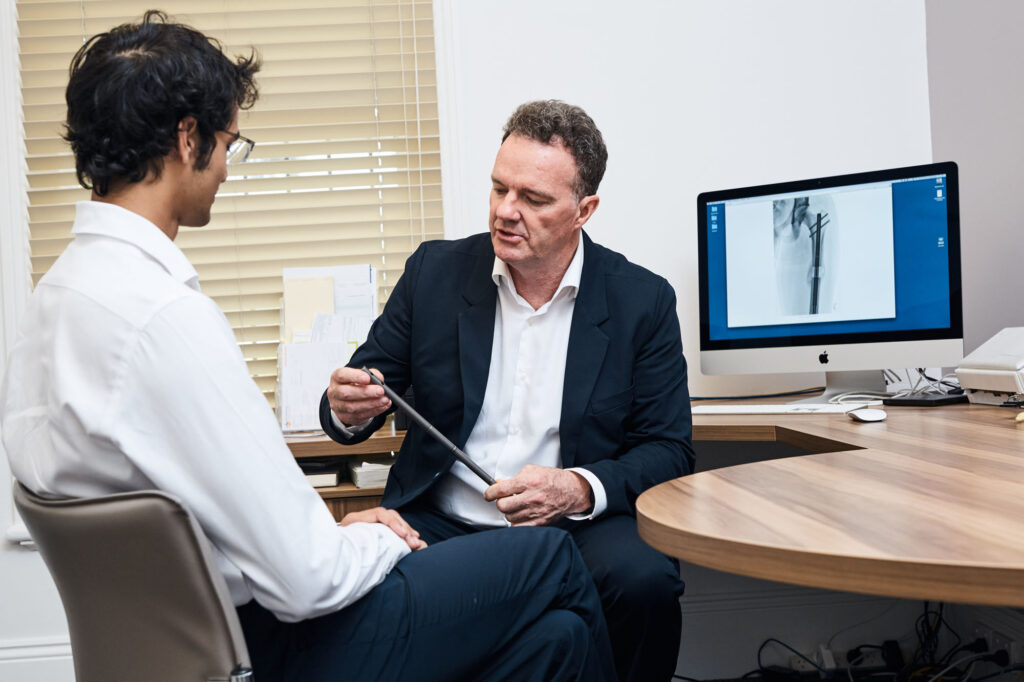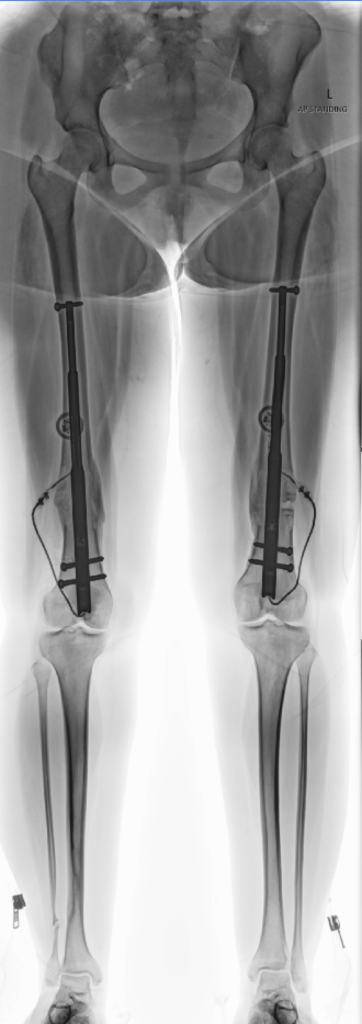Appointment 1: Discussion and Evaluation
If interested in stature lengthening, you should obtain a referral to see A/Prof Leo Donnan or Dr Stewart Morrison. In this appointment, they ask you about your goals with regard to height, discuss your medical history, and discuss any functional problems you have because of your current height. They will measure your height and weight, examine the joints of your legs, observe your gait, review any previous x-rays or imaging investigations that you have had. They will then potentially obtain new x-rays.
Based on this assessment, they will determine if you are appropriate for stature lengthening, and then arrange for you to have an appointment with a physiotherapist, psychiatrist, laboratory for blood tests and appropriate medical imaging.

Appointment 2: Surgical Planning, Options, and Agreement
Based on the amount of height you wish to obtain, and the results of the investigations performed, Dr Leo Donnan and Dr Stewart Morrison will explain the lengthening options appropriate for you. For height increase (3-5 cm), it may be appropriate to lengthen the femurs only, but for greater amounts, both femur and tibial lengthening is required to maintain body proportions.
While a limb is being lengthened, you can only bear 10 kg of weight.
Option One: Right Leg First, Left Leg Second (Or the other way around)
We lengthen both the femur and tibia in one leg only, so that the patient may use crutches and bear weight through their other leg, while lengthening is occurring. After this leg has fully healed, we operate on the other leg. The drawbacks to this is that the lengthened leg will be significantly longer until the second side is operated on and a significant shoe raise will be required. It also relies on participation in active physiotherapy so that the leg, which is being lengthened at two locations, remains supple
Option Two – Both Femurs first, both Tibias second
We lengthen both of the femurs at the same time. Once the femurs have healed, we return and lengthen both tibias at the same time. The key advantage of this is that the legs remain of equal length throughout treatment period the disadvantage, is that while lengthening is occurring, the patient must use a wheelchair at all times.

There may be considerations either based on your surgeon’s assessment or pertaining to your own life situation, that make one option more ideal for you than the other. It is unsafe to attempt to lengthen all four bones at once, the initial surgery would be too great and the body is unable to produce that much new bone. Once you have decided on the appropriate option for you, a time frame for surgeries will be drawn up, as well as a quotation for all the costs involved.
The reports from the psychiatrist and physiotherapist will also be considered in making the final decision to proceed with surgery.


Hospital Admission and Surgery
You will be asked to use a specialised body wash for the days prior to surgery. Surgery is conducted under general anaesthetic, with the leg carefully washed and prepared in a sterile fashion to minimize the risk of infection.
For each bone being lengthened, a small cut is made through which the bone is carefully cut. Another small incision (either on the side of the hip or below the kneecap) is made which allows passage of the nail into the bone. A further three or four small incisions will be made to place screws.
Once the lengthening nail has been successfully implanted and secured, a transceiver is used to test the nail. Dissolvable stitches are used for all wounds. The leg is neatly dressed with bandages, and a marking pen will be used to mark the point on the skin, where the transceiver for lengthening needs to be held.
Like any operation, there will be some discomfort afterwards, and we work with the anaesthetist to ensure you are as comfortable as possible. You may be placed on a continuous passive motion machine (CPM) for knee movement and will have compression stocking on your legs as part of thrombosis protection. You will meet with physiotherapist and occupational therapists to explain your mobility restrictions and practice using crutches or a wheelchair. You will also be educated in how to use the lengthening transceiver.
After Surgery
Lengthening Phase ( 8 – 10 Weeks)
On being discharged from hospital you will be provided with a schedule, detailing the date at which lengthening will commence, and how many times per day you must perform it. Each lengthening is no more than one quarter of a millimetre, often less, and will not be painful. The leg over all will have some aching pain, described by some as like “the day after having performed heavy exercise”.
The transceiver which you are sent home with has a way of ensuring you are performing the correct amount of lengthening. It is important you stick to the schedule. Lengthening too slowly, or missing lengthenings, may cause the bone segments to fuse together making further lengthening impossible. Lengthening too quickly, may cause dangerous problems with nerves or joints with catastrophic consequences


You will participate in regular supervised physiotherapy over this period, to ensure that the muscles and tendons are stretching in a balanced fashion as the leg becomes longer.
You will have regular appointments with A/Prof Donnan or Dr Morrison on a weekly or fortnightly basis. At these appointments, x-rays will be performed to assess the quality of the new bone that is growing, and your leg will be assessed to ensure that it is tolerating the lengthening well. Please bring the transceiver to any of these appointments, so that it is available should any troubleshooting need to be performed.
Once lengthening is complete, the transceiver no longer needs to be used, and you enter the ‘consolidation phase’.
Consolidation Phase (6 – 8 Weeks)
In this phase, lengthening has been completed, and the soft new bone that has been generated gradually forms into strong hard bone. Over this period physiotherapy continues to get the muscles and tendons of the leg used to their new length. X-rays will be taken approximately every four weeks, to assess when the leg is ready to bear full weight. Once this has occurred, crutches or wheelchair may be discarded.

Rehabilitation Phase and Removal (5 – 12 months)
The bones that were lengthened have now reached their full strength. It is normal for work with physiotherapy to continue for many months, though you will no longer need crutches or a wheelchair. If you have had both bones in one leg lengthened, you will need to wear a raise on the shoe of the shorter leg to improve your walking until the other leg is then lengthened as well. Some people choose to return to sport during this period, please discuss this with your treating surgeon.
All lengthening nails need to be removed, this is usually performed 12 to 18 months after the lengthening surgery. This operation may be able to be aligned with other procedures.
Final Result
You have now had all your bones lengthened and, the bone has healed, muscle strength has returned, and the rods have been removed. Your legs are as strong as they were before. You are now taller. Congratulations

